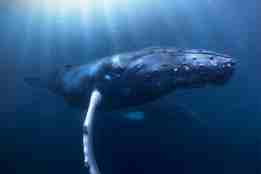Follow whales on their autumn migration live

The humpback whales were tagged near Svenskeøya in the Barents Sea in September.
Photo: Audun RikardsenPublished: 16.10.2018 Updated: 31.10.2018
In September, ten humpback whales were tagged near Svenskeøya in the Barents Sea, a well-known feeding area for the species.
Now they have started their migration, and anyone can follow their journey here.
The whales are being tracked as part of the Whaletrack project, a joint initiative between the Institute of Marine Research (IMR) and UiT The Arctic University of Norway.
A short break to the Caribbean
Researchers already know that in the autumn these whales usually migrate from the Barents Sea to some large banks off the island of Hispaniola in the Caribbean.
“That’s a few thousand kilometres. The journey takes them between two and three months each way. And they do it without any significant feeding breaks”, says Nils Øien, a whale researcher at the IMR.
However, it doesn’t mean that they stay long in warmer climes.
“One of the whales we followed over a long period headed off to the Caribbean, turned around the day it arrived, and swam back to the Barents Sea”, says Øien.
What is the point in that, the researchers want to know. Why spend so much time and energy migrating such a long distance only to turn back after a short time?
“We don’t really know the answer. For a long time these banks have been a good area for feeding and nursing, but we think many of the whales travel there out of habit. You could call it an evolutionary habit”, says Øien.
Depth measurements may explain feeding habits
The researchers had two main aims with tracking these whales. They have already found out where the whales migrate to: the Caribbean.

The second aim is to find out how the humpback whales use the Barents Sea. How do they feed and what do they feed on? Hopefully the whale tags will also answer those questions.
“The tags can record the depth of the whales. That will in turn help us to understand what they are eating”, says Øien.
The researchers expect the tags to continue working and transmitting signals for at least two months.